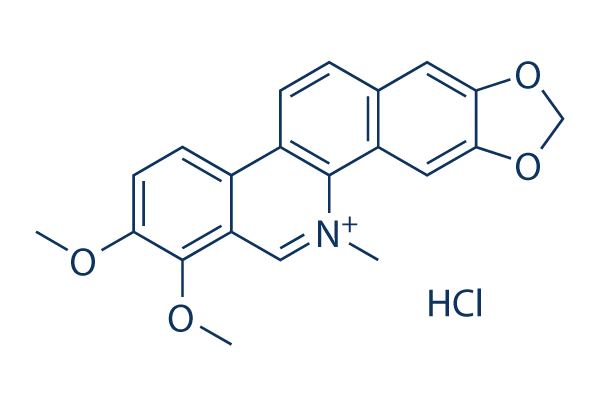|
受注:045-509-1970 |
技術サポート:tech@selleck.co.jp 平日9:00〜18:00 1営業日以内にご連絡を差し上げます |
化学情報

|
Synonyms | Broussonpapyrine chloride | Storage (From the date of receipt) |
3 years -20°C powder 1 years -80°C in solvent |
|||
| 化学式 | C21H18NO4.HCl |
||||||
| 分子量 | 384.83 | CAS No. | 3895-92-9 | ||||
| Solubility (25°C)* | 体外 | DMSO | 3 mg/mL (7.79 mM) | ||||
| Water | Insoluble | ||||||
| Ethanol | Insoluble | ||||||
| 体内 (毎回新しく調製した物を用意してください) |
|
||||||
|
* <1 mg/ml means slightly soluble or insoluble. * Please note that Selleck tests the solubility of all compounds in-house, and the actual solubility may differ slightly from published values. This is normal and is due to slight batch-to-batch variations. |
|||||||
溶剤液(一定の濃度)を調合する
生物活性
| 製品説明 | Chelerythrine Chloride (NSC 646662, Broussonpapyrine) is a potent, selective antagonist of PKC with IC50 of 0.66 mM. |
|---|---|
| in vitro | Chelerythrine Chloride (NSC 646662) interacts with the catalytic domain of PKC, is a competitive inhibitor with respect to the phosphate acceptor (histone IIIS) with Ki value of 0.7 μM and a non-competitive inhibitor with respect to ATP. It shows potent cytotoxic effects against L-1210 cells with IC50 of 0.53 μM. This compound does not alter any activity of PKA, TPK and Ca/CM-PK, and its inhibitory effect on PKC activity does not vary among the various substrates including GS, MLC, MBP and Fibrinogen. [1] It inhibits PKC activity in crude cell extracts from SQ-20B cells in a dose dependent manner. Chelerythrine decreases cell viability as determined by the MTT assay in a dose-dependent manner in SCC35, JSQ3, SQ20B and SCC61 cells. [2] At 5 μM, it suppresses VEGF-induced expression of ICAM-1, VCAM-1, and E-selectin in HUVECs. This compound also suppresses VEGF-induced NF-κB activity in HUVECs and all suppresses basal and VEGF-induced leukocyte adhesiveness in HUVECs. [3] At concentrations of 6 mM-30 mM, it rapidly induces pyknosis, shrinkage and subsequent cell death in cardiac myocytes. Chelerythrine(30 μM)-induced myocyte death is accompanied by nuclear fragmentation and activation of caspase-3 and -9 in primary culture of neonatal rat ventricular myocytes. At 10 μM, it causes cytochrome c release from mitochondria, suggesting that ROS mediates chelerythrine-induced cytochrome c release in cardiac myocytes. [4] It displaces the fluorescently labeled BH3 domain peptide from a recombinant GST-BcLXL fusion protein with IC50 of 1.5 μM. At 2.5 μM and 5 μM for 16 hours, it induces a substantial decrease in mitochondrial potential as indicated by an increase in JC-1 green fluorescence in human neuroblastoma SH-SY5Y cells. At 5 μM, it also induces the appearance of sub-G1 DNA that is indicative of apoptosis in SH-SY5Y cells. At 10 μM, it induces mitochondrial potential change, CytC release from the mitochondria in SH-SY5Y cells. [5] |
| in vivo | Chelerythrine Chloride (NSC 646662) (5 mg/kg i.p.) results in tumor growth delay in mice bearing SQ-20B xenografts. [2] This compound (5 mg/kg) treatment significantly increases TUNEL-positive nuclei in the myocardium as well as cleaved forms of caspase-3 and -9 in adult rat. [4] |
| 特徴 | Chelerythrine is at least 100-fold more selective for PKCs than for other kinases. |
プロトコル(参考用のみ)
| キナーゼアッセイ | assay for protein kinase C | |
|---|---|---|
| The purified protein kinase C is prepared from rat brain. Briefly, the incubation mixture (200 μL) contains 20 mM Tris/HCl buffer (pH 7.5), 10 mM MgCl2, 200 μg/mL histones, micelles makes with 700 μM phosphatidyl serine and 180 μM 1,2-dioleine in 0.3% triton X100, 0.2 mM CaCl2, 100 μM ATP, [γ-32P ]-ATP (105 dpm), Chelerythrine Chloride (NSC 646662) to be tested (solubilized in dimethylsulphoxyde) and the enzyme (0.5 μg protein). After incubation at 30℃ for 3 minutes, the reaction is terminated by the addition of 3 mL of 20% trichloroacetic acid. Acid-precipitable materials are collected on Whatman GFE filters and extensively washed with ice-cold 20% trichloroacetic acid. The radioactivity on the filters is measured using a liquid scintillation counter. Protein kinase C activity is corrected for non-specific activity by assaying in the absence of micelles and CaCl2. | ||
| 細胞アッセイ | 細胞株 | L-1210 cells |
| 濃度 | ~10 μM | |
| 反応時間 | 2 days | |
| 実験の流れ | The lymphocytic mouse leukemia L1210 cells are plated sparsely at 1×104 cells per well in 24-well cluster plates in RPMI 1640 medium containing 10% foetal calf serum, 4 mM glutamine, 100 U/mL penicillin, 100 pg/mL streptomycin sulphate and Chelerythrine Chloride (NSC 646662) to be tested (solubilized in dimethylsulphoxyde ). After a 2 day incubation period at 37 ℃ in a humidified atmosphere (5% CO2 in air), growth is monitored by counting cell numbers in a coulter-counter. IC50 values are calculated on the basis of the linear regression lines established for this compound. |
|
| 動物実験 | 動物モデル | mice bearing SQ-20B xenografts |
| 投薬量 | 5 mg/kg | |
| 投与方法 | Intraperitoneal injection | |
参考
|
Selleckの高級品が、幾つかの出版された研究調査結果(以下を含む)で使われた:
| Trace amine-associated receptor 1 regulation of Kv1.4 channels in trigeminal ganglion neurons contributes to nociceptive behaviors [ J Headache Pain, 2023, 24(1):49] | PubMed: 37158881 |
| Effect of feeding regimen on circadian activity rhythms of food anticipatory by ghrelin hormone in a pig model [ Nutr Neurosci, 2022, 1-19] | PubMed: 35249475 |
| An Early and Robust Activation of Caspases Heads Cells for a Regulated Form of Necrotic-like Cell Death [ J Biol Chem, 2015, 290(34):20841-55] | PubMed: 26124276 |
| Signaling pathways of a structural analogue of apelin-12 involved in myocardial protection against ischemia/reperfusion injury [ Peptides, 2015, 73:67-76] | PubMed: 26348269 |
長期の保管のために-20°Cの下で製品を保ってください。
人間や獣医の診断であるか治療的な使用のためにでない。
各々の製品のための特定の保管と取扱い情報は、製品データシートの上で示されます。大部分のSelleck製品は、推薦された状況の下で安定です。製品は、推薦された保管温度と異なる温度で、時々出荷されます。長期の保管のために必要とされてそれと異なる温度で、多くの製品は、短期もので安定です。品質を維持するが、夜通しの積荷のために最も経済的な貯蔵状況を用いてあなたの送料を保存する状況の下に、製品が出荷されることを、我々は確実とします。製品の受領と同時に、製品データシートの上で貯蔵推薦に従ってください。
